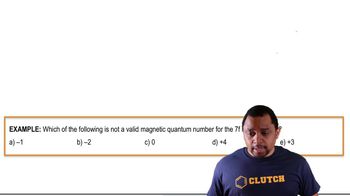Using the molecular orbital energy ordering for second-row homonuclear diatomic molecules in which the π2p orbitals lie at higher energy than the σ2p, draw MO energy diagrams and predict the bond order in a molecule or ion with each number of total valence electrons. Will the molecule or ion be diamagnetic or paramagnetic? a. 10
Ch.11 - Chemical Bonding II: Molecular Shapes, VSEPR & MO Theory

All textbooks Tro 5th Edition
Tro 5th Edition Ch.11 - Chemical Bonding II: Molecular Shapes, VSEPR & MO Theory
Ch.11 - Chemical Bonding II: Molecular Shapes, VSEPR & MO Theory Problem 76d
Problem 76d
 Tro 5th Edition
Tro 5th Edition Ch.11 - Chemical Bonding II: Molecular Shapes, VSEPR & MO Theory
Ch.11 - Chemical Bonding II: Molecular Shapes, VSEPR & MO Theory Problem 76d
Problem 76dChapter 11, Problem 76d
Using the molecular orbital energy ordering for second-row homonuclear diatomic molecules in which the π2p orbitals lie at higher energy than the σ2p, draw MO energy diagrams and predict the bond order in a molecule or ion with each number of total valence electrons. Will the molecule or ion be diamagnetic or paramagnetic? d. 14
 Verified step by step guidance
Verified step by step guidance1
Identify the second-row homonuclear diatomic molecule with 14 valence electrons. This corresponds to the molecule N2.
Draw the molecular orbital (MO) energy diagram for N2. For second-row diatomic molecules, the order of orbitals is: \( \sigma_{1s} \), \( \sigma^*_{1s} \), \( \sigma_{2s} \), \( \sigma^*_{2s} \), \( \sigma_{2p} \), \( \pi_{2p} \), \( \pi^*_{2p} \), \( \sigma^*_{2p} \).
Fill the molecular orbitals with the 14 valence electrons, starting from the lowest energy orbital and following the Pauli exclusion principle and Hund's rule.
Calculate the bond order using the formula: \( \text{Bond Order} = \frac{(\text{Number of electrons in bonding MOs} - \text{Number of electrons in antibonding MOs})}{2} \).
Determine if the molecule is diamagnetic or paramagnetic. A molecule is diamagnetic if all electrons are paired and paramagnetic if there are unpaired electrons.

Verified video answer for a similar problem:
This video solution was recommended by our tutors as helpful for the problem above.
Video duration:
5mWas this helpful?
Key Concepts
Here are the essential concepts you must grasp in order to answer the question correctly.
Molecular Orbital Theory
Molecular Orbital (MO) Theory describes how atomic orbitals combine to form molecular orbitals that can be occupied by electrons. In diatomic molecules, these MOs can be bonding or antibonding, influencing the molecule's stability and properties. The energy levels of these MOs are determined by the types of atomic orbitals involved and their relative energies, which is crucial for predicting molecular behavior.
Recommended video:
Guided course

Molecular Orbital Theory
Bond Order
Bond order is a measure of the number of chemical bonds between a pair of atoms, calculated as the difference between the number of bonding and antibonding electrons divided by two. A higher bond order indicates a stronger bond and greater stability of the molecule. For example, a bond order of 1 corresponds to a single bond, while a bond order of 2 indicates a double bond.
Recommended video:
Guided course

Average Bond Order
Magnetism in Molecules
The magnetic properties of a molecule, whether it is diamagnetic or paramagnetic, depend on the presence of unpaired electrons in its molecular orbitals. Diamagnetic molecules have all electrons paired and are not attracted to a magnetic field, while paramagnetic molecules contain unpaired electrons and are attracted to magnetic fields. This property is essential for understanding the reactivity and stability of molecules.
Recommended video:
Guided course

Magnetic Quantum Example
Related Practice
Textbook Question
Textbook Question
Using the molecular orbital energy ordering for second-row homonuclear diatomic molecules in which the π2p orbitals lie at higher energy than the σ2p, draw MO energy diagrams and predict the bond order in a molecule or ion with each number of total valence electrons. Will the molecule or ion be diamagnetic or paramagnetic? c. 13
Textbook Question
Use molecular orbital theory to predict if each molecule or ion exists in a relatively stable form. a. H22- b. Ne2 c. He22+ d. F22-
Textbook Question
Apply molecular orbital theory to predict if each molecule or ion exists in a relatively stable form. a. C22+ b. Li2 c. Be22+ d. Li22-
Textbook Question
According to MO theory, which molecule or ion has the highest bond order? O2, O2- , O22-